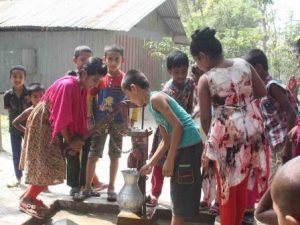 |
|
Students collecting water from the well constructed in 2017 |
What is the JWF Fund?
Japan Water Form (JWF) Fund was established in 2005 to support organizations aiming at solving water-related issues at a grass-roots level. It is formed and operated by utilizing membership fees of JWF and donations through JWF’s “Charity for Water”.
During the past 14 years, 170 projects were implemented and more than 200,000 people were benefited in the regions of Asia-Pacific, Africa, Central America and South America.
What is the follow-up observation?
Our priority is placed on responding to the issues and needs of the field in an efficient and effective way.
To grasp and understand changes of the issues and needs after one year from the completion of the projects, we have been carrying out the follow-up observations for the projects since 2015.
In FY 2018, which is the fourth year since the start of the follow-up observations, we asked 7 grass-roots organizations in Ethiopia, Cameroon, Kenya (2 projects), India, Bangladesh and Philippines that had been granted the JWF Fund 2017 to conduct the follow-up observations. As a result of our request, we received consents from the 6 organizations excluding the one in Ethiopia. With their cooperation, the follow-up observations were conducted to see the conditions, one year after the completion.
Report
Japan Water Forum Fund 2017 follow-up report (PDF)
Out line of the projects in JWF Fund 2017 and Follow-up results in 2018
1. Water For Life Project Nkum Ekie (Cameroon)
(1)Outlines of the project of JWF Fund 2017
・Organization: Community Awareness and Development Association Cameroon (CADAC) (#172)
・Project title: Water For Life Project Nkum Ekie
・Country/Area: Cameroon/Centre Region
・Project period: October 2017 to March 2018
・Number of beneficiaries: direct beneficiaries 179 people and indirect beneficiaries 2,000 people
・Cost: 1,594.54 USD (JWF Fund: 1,000 USD, Contributions by the beneficiaries: 100 USD, CADAC and others: 494.54 USD)
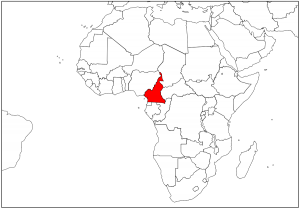 |
| Cameroon |
Background
According to the surveys carried out by National Institute of Statistics on Households between 2014 and 2016, the water-related diseases still remain rampant in the targeted area, though the water-related diseases in other areas in the country have improved. People living in the Nkum Ekie village take water from a distant river from their village, and they use that water to wash dirty cloths, dishes, other materials and body. A lot of mosquitoes breed around the water source, which makes children and women at risk of malaria. Even the community health center does not have clean water supply facility.
Outputs
1) Coordination Meeting was held.
2) Workshop on water, sanitation and health was held.
3) One well was constructed.
4) Water quality test was carried out.
Because of these activities, the people in the Nkum-Ekie village could access to clean drinking water so that reduction of diseases caused by contaminated water can be expected.
(2) Results of the follow-up observation in 2019
- One well constructed by the project
As a result of the field survey, it was discovered that the constructed well was not used due to the following three reasons:
The first reason was the issue of the operation and maintenance framework of the well. Initially, a management committee was to be established to ensure the effective management and sustainability of the well, and community representatives including the village chief were supposed to comprise the committee. However, the committee did not function well. Because there had been some disputes regarding water use between the village chief and the community people in the past, and the community people were uneasy about the involvement of the village chief in the committee. Therefore, the committee had been far cry from well-functioning and the constructed well was not used much.
The second reason rested in the quality of water from the well, which was not good in quality; though some community people were using the water from the well for drinking and domestic purposes.
The last reason was due to the relocation of the health center which was an advocator for the project. The center was relocated so their activities in the area were halted due to managerial reasons.
To handle these issues, CADAC will take the responsibility to implement the following two measures.
- Setting up of a new management committee: CADAC will help to establish a local water management committee to manage the usage of the well and to ensure the sustainability of the project. CADAC will act as a coordinator for this committee when it is in place and will mediate the conflicts until they are settled appropriately.
- Cleaning up of the well: CADAC will hire a technician to handle the cleaning of the well so that it is ready for the community to use. This work needs to and will be done by the end of the dry season (approximately before May).
2. Equipping the Eshiru primary school with 1 block of 3 re-usable pit-latrines and 4 hand-washing facilities, and educate 1,200 pupils in the school on skills in hand-washing and the importance of pit-latrines (Kenya)
(1) Outlines of the project of JWF Fund 2017
・Organization: Renewed Hope Group (RHG) (#054)
・Project title: Equipping Eshiru primary school with 1 block of 3 re-usable pit-latrines and 4 hand-washing facilities, and 1,200 pupils in the school with skills in hand-washing and importance of pit-latrines
・Country/Area: Kenya/Kakamega County
・Project period: October 2017 to February 2018
・Number of beneficiaries: 1,220 people (800 girls, 400 boys and 20 teachers)
・Cost: 1,339 USD (JWF Fund: 1,000 USD, Contributions by the beneficiaries: 199 USD, RHG: 140 USD)
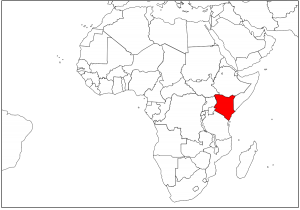 |
| Kenya |
Background:
The Eshiru public primary school, which has 1,200 poor pupils, has only 2 pit latrines that are fully filled up every half a year. Pupils have to stand in a queue to use existing pit-latrines during breaks or lunch time. As a result, most of them delay returning to classes and often defecate open in bushes around the school to catch up with time. Pupils do not have enough knowledge about importance of using pit-latrines and hand-washing. In addition to that, the school lacks hand washing facilities. At-least 4 out of every 10 children in the school are infected with water-borne diseases every year, therefore, a local public health authority regularly closes down the school temporarily.
Outputs:
1) Project Implementation Committee was established.
2) 3 VIP pit latrines*1 and 1 urinal unit were constructed.
3) 4 hand washing facilities were installed.
4) 2 training workshops on water and sanitation were held.
5) Operation and maintenance framework was established.
*1:VIP latrine is an abbreviation for Ventilated Improved Pit Latrine. The latrine is a sanitation facility equipped with ventilation pipes to prevent odors and flies.
Because of these activities, teachers and pupils could use clean sanitation facilities, so that the school environment can be improved.
(2) Results of the follow-up observation in 2019
- 3 VIP pit latrines and 1 urinal unit were constructed and 4 handwashing kits were installed by the project.
– The 3 VIP pit latrines, 1 urinal unit and 4 handwashing kits are in good condition without any damages. The facilities are used by the pupils and teachers of the school and cleaned up regularly.
– The water used for the hand-washing kits are supplied from a rainwater harvesting system installed in the school and also from a nearby protected spring/well. - Operation and maintenance framework
– The governing board of the Eshiru Primary School that practically manage the sustainability of the VIP latrines, urinal unit and handwashing kits collects and keeps small fees from the 1,200 pupils for repairing of the facilities when the needs arise: collaborating with the local government’s department of water and sanitation, the board solicits and hires skilled and experienced engineers or contractors or consultants. Their expenses are covered by the funds they are collecting to pay for the renovation services.
– The facilities are cleaned up regularly by the organized roster of pupils and school’s subordinate staff. A group of 6 girls and 3 boys as one roster cleans up the VIP pit-latrines and the urinal unit in mornings (every Monday, Wednesday and Friday). The subordinate staff has their own rosters, 3 in a group, and cleans the VIP latrines, the urinal unit and handwashing kits every Saturday morning. This way, those pupils and subordinate staff are working together in cleaning the VIP latrines in particular days, while they are also sharing duties such as collecting water for cleaning. - Behavior changes
– The construction of the VIP latrines in school has made the pupils to always use the pit-latrines and avoid open defecation in nearby bushes. Cases of open defecation in nearby bushes became extremely low or have completely vanished.
– The pupils wash their hands after call of nature and whenever they are dirty; and they thoroughly wash water and food containers before using them. - Changes among the beneficiaries
– Because of the sanitation facilities as well as the behavior changes, their health conditions improved. The number of cases of waterborne diseases among the pupils in school has drastically dropped and unhealthy bad smell from human excretion is no longer being felt in the school.
– Because of the sanitation facilities as well as the behavior changes, positive changes in school operation and education in the Eshiru Primary School were evident. Reduced foul smell and waterborne diseases in the school have improved the learning environment, the attendance in terms of time spent at school for each pupil, and the number of pupils attending school. In addition, the number of instructions given by the public health officer decreased.
Voices from the beneficiaries
- Mr. Jairus Wanyonyi, 14 years old, a pupil of the school
– I use the VIP latrines and handwashing kits. I feel great and highly value them. It was my habit, not a surprise at all that not just me but a majority of my colleagues used to defecate in bushes around the school to avoid old damaged latrines and long queues to use them. But now I know it was wrong. - Ms. Nafula Nabwile, 12 years old, a pupil of the school
– I use the toilets and handwashing kits. I feel excited, happy and inspired to always use toilets and handwashing kits after using the toilet. It is a new experience to me since I had never washed our hands after call of nature. I hated long queues and unhygienic conditions of old toilets that are already filled up. - Mrs. Janet Wasike, 35 years old, a teacher of the school
– After the project, I feel positive changes in my health condition as well as the school environment in terms of sanitation and hygiene. I rarely encounter waterborne diseases now and feel healthy and secure to deliver my duties as a teacher at the Eshiru Primary School. Teaching at the Eshiru primary school is now enjoyable and without interferences. Since cases of waterborne diseases among pupils has dropped down, foul smell as a result of outdoor defecation has drastically reduced and pupils can now return to classrooms on time after breaks since there is no more congestion on queues to use pit-latrines. After the end of the project, I have never encountered cases of school closure on account of poor sanitation or hygiene. - Ms. Christine Sande, 32 years old, an officer of the local government, department of water and sanitation
– After the project, I feel positive changes in my health condition as well as in the school in terms of sanitation and hygiene. The project conforms to the Kenya Vision 2030*2 and Kenya’s constitution of ensuring adequate sanitation and proper hygiene for every citizens. After its implementation, the school is somehow filling a pressing gap of sanitary facilities and heading in good looks in regard to sanitation and hygiene.
*2:Kenya Vision 2030 is the country’s development blueprint covering the period 2008 to 2030. It aims to transform Kenya into a newly industrializing, “middle-income country providing a high quality life to all its citizens by the year 2030”.
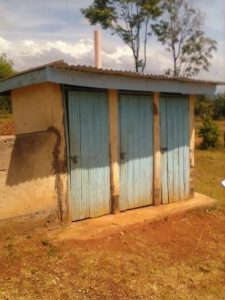 |
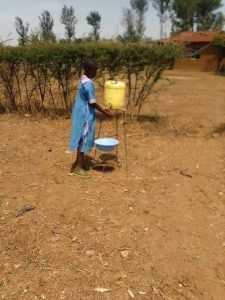 |
|
Current situation of the constructed VIP toilet |
Pupils using the handwashing kit |
3. Promoting access to safe water in the Luyekhe community through construction of 1 open spring well with clean water (Kenya)
(1) Outlines of the project of JWF Fund 2017
・Organization: Ufanisi Women Group (UWG) (#031)
・Project title: Promoting access to safe water in the Luyekhe community through construction of 1 open spring well with clean water
・Country/Area: Kenya/Bungoma County
・Project period: October 2017 to February 2018
・Number of beneficiaries: 750 people (150 women, 150 men and 450 children)
・Cost: 1,389 USD (JWF Fund: 1,000 USD, Contributions by the beneficiaries: 258 USD, Ufanisi Women Group: 131 USD)
 |
| Kenya |
Background:
About 150 households live in the Luyekhe community and they use water from a heavily contaminated open spring. This water source is not protected well and people defecate open, therefore human excrete and other wastes flow into the spring. People consume the water without treatment. This leads to water-borne disease such as diarrhea and deaths. Almost half of the people in the community visit local clinics. A public health authority occasionally closes down community’s school due to outbreak of the diseases.
Outputs:
1) Project Implementation Committee was established.
2) 1 spring well was protected.
3) Training workshops on water and operation and maintenance were held (3 days).
4) Operation and maintenance framework was established.
5) Water quality test was carried out.
Because of these activities, 750 people in the Luyekhe community could access to safe water, therefore reduction of diseases caused by contaminated water can be expected.
(2) Results of the follow-up observation in 2019
- Constructed facility to protect the spring well
– The spring well is working as planned. The beneficiaries use the spring well and its equipped facilities properly. Safe water is available for the 750 beneficiaries throughout the year. No people in the Luyekhe community still use water from the old contaminated pond for their drinking water or domestic water. - Project Exit Committee (PEC)
– 10 persons who were selected from the heads of 150 beneficiary households in the community still belong to PEC. However, PEC was expanded to 20 persons; and therefore there is an addition of 10 new persons to PEC. Additional 10 persons to PEC were required so that all groups of beneficiaries can represent each group in PEC and enough resources are solicited towards repair, maintenance and operation of spring well as well as for project’s sustainability.
– The committee has been working now. Actions that were taken by PEC so as to keep the spring well properly functioned, including collecting of small affordable fees from the 150 direct beneficiary households that fetch and use clean and safe water from the spring well; and keeping collected funds safely so that they can use the money for repairing and maintaining the constructed spring well. - Changes among the beneficiaries
– Crystal clear messages on health and hygiene content were delivered during the community engagements and sensitizations trainings, which were well understood and put into action by the community people. The community people now boil the water from the spring well before drinking and others are adopting the methods of chlorination, sun pasteurization and use of water guard to purify water for drinking. They are also washing their containers before collecting water, just to stress a point on proper water handling.
– The outbreak of waterborne diseases is now a thing of the past after the protection of the spring well. This means that the community is now healthier and richer because their cumulative expenditure on medication has gone down.
Voices from the beneficiaries
- Mrs. Anna Maloba, Volunteer Health Officer
– I found positive changes in using water by the community people after the project. The constructed Luyeke spring well is now supplying water to over 150 poor families from the Luyekhe village and its neighboring communities. This huge number of families is because the spring well is now reliable and yields safe and clean water throughout the year, even during dry seasons. The community people now understand use of contaminated water was not good. This ultimate positive change is already eradicating diarrhea. They are now investing extra valuable time retrieved from fetching contaminated water from distant open sources and taking care of diarrhea into productive work like farming, which will eventually lift their socioeconomic status. - Mrs. Sarah Mumbua, Small-scale farmer
– I use the spring well and feel that the water from the spring well is clear, clean and not contaminated with dirties; unlike previously when it was very heavily polluted.
– Because of improved access to safe and clean water throughout the year from the protected spring well nearby, I can save about 2 hours per a day from the time I previously spent to collect contaminated water from distant open water source. - Mr. Geoffrey Asombi, Community Leader
– I use the spring well. I really enjoy coming to the spring well to collect the sparkling, clean and fresh water. Before the spring was protected, it was a task of women and girls to collect water alone for household use. The main excuse of men and boys was that, it was so shameful to form long queues with women and girls to scramble for the dirty water together in distant open sources. However, after the protection, most men and boys were convinced that development is a collective effort that requires both females and males. I cherish the spring well and it gives me an improved self-esteem because now I am drinking water from a safe source. I use the same water for our animals, and I also use the water when cooking the food we eat and washing clothes every day.
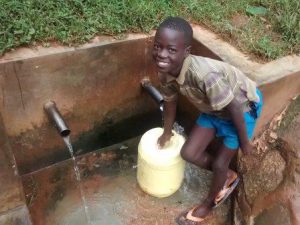 |
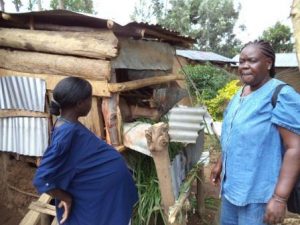 |
|
A boy collecting water from the facility |
An interview with Mrs. Mumbua (Left) |
4. Repair of wells, bore wells, awareness on hygiene and training program in repair of bore wells to unemployed youth (India)
(1) Outlines of the project of JWF Fund 2017
・Organization: Rural Action In Social Emancipation (RAISE) (#047)
・Project title: Repair of wells, bore wells, awareness on hygiene and training program in repair of bore wells to unemployed youth
・Country/Area: India/Andhra Pradesh State
・Project period: October 2017 to March 2018
・Number of beneficiaries: 230 people (80 women, 100 men and 50 children)
・Cost: 1,030 USD (JWF Fund: 1,000 USD, Contribution by RAISE: 30 USD)
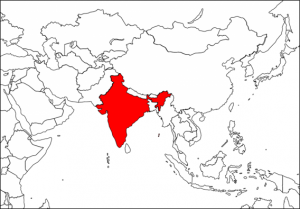 |
| India |
Background:
Most of the people in targeted village belong to lower class and they are illiterate. The village has shallow wells and bore wells which were constructed a few decades ago. The shallow wells have become dirty due to ignorance of proper usage, which led to various water-borne diseases such as dysentery, diarrhea, amoebiasis, and hepatitis. In addition to that, water in the wells mingled with mud due to aging of the boreholes.
Outputs:
1) Repairing and cleaning of 5 wells were conducted.
2) 2 awareness camps on sanitation and hygiene were held.
3) A training on operation and maintenance was held.
4) Water quality test was carried out.
Because of these activities, the people in the village could access to safe drinking water so that reduction of diseases caused by contaminated water can be expected.
(2) Results of the follow-up observation in 2019
- Repaired and cleaned 5 wells
– The wells are working. There is no change on the quality and quantity of water from them.
– 230 beneficiaries are using the wells as planned. The amount of water from the wells meets the needs of the beneficiaries throughout the year. - Operation and maintenance framework
– A steering committee established by the beneficiaries is working actively. The committee members taking care of the wells properly.
– After the project, youth who participated in the training program on rehabilitation and cleaning of wells cleaned each well at once. - Changes among the beneficiaries
– After repairing, the people are taking care of the well appropriately in the usage of water without impairing the good quality of water. - – Having good health, the number of children attending the school has been increased. As their parents are in good health as well, they do not need to spend money for the medicine and doctor charges. So they are able to buy good healthy food with the remaining money.
Voices from the beneficiaries
- Mr. SK. Naim Basha, 21 years old, a youth who participated in the training
– I use the wells. Now the condition has improved. Everything is clean and neat.
– With what we learned we also repaired a bore next to our village. I got a salary for that. I am happy. - Mrs B.Veronika , 46 years old, a member of the steering committee
– The well is very helpful, which made it easier to fetch water from the well after installing the wheels to the will.
– We monthly inspect the wells and bore wells, also the cleaning work is conducted twice a month as a role of the committee.
– After the project, people’s mind on access to safe drinking water as well as sanitation and hygiene was changed. Everyone feels responsible for the usage of the wells and bore wells. - Mrs A. Malliswari , 38 years old
– I am using the wells regularly. Now the water is clean without any dust and rust.
– I found lots of change in the beneficiaries. Now everyone takes responsibility in maintaining the well and bore well
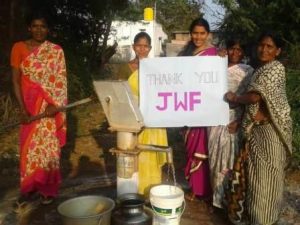 |
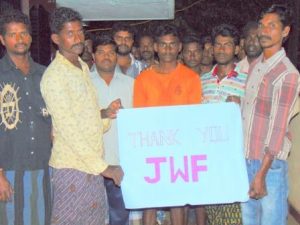 |
|
Repaired and cleaned wells with the village people |
Young people participated in the training for operation and maintenance of the wells |
5. Ensure child education through construction of hygienic latrine & water supply (Bangladesh)
(1) Outlines of the project of JWF Fund 2017
・Organization: BASCO Foundation (#157)
・Project title: Ensure child education through construct a hygienic latrine & water supply
・Country/Area: Bangladesh/Magura district
・Project period: October 2017 to March 2018
・Number of beneficiaries: 80 people (24 girls, 16 boys and 40 women)
・Cost:1,365 USD (JWF Fund: 1,000 USD, Contributions by the beneficiaries: 125 USD and BASCO Foundation: 240 USD)
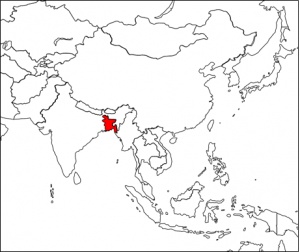 |
| Bangladesh |
Background:
In the Roygram village, there is no educational facility such as a public or private primary school. There is only one primary school with 40 children which is operated by local communities. As this school cannot get any support from the government, it does not have any facility for water and sanitation. Therefore, the students defecated in open field and drank dirty water. Especially girls were unwilling to defecate open, therefore they do not want to go to school. It makes many girls dropped out of school and their parents were reluctant to encourage their daughters to go to school.
Outputs:
1) 1 pit latrine*3 and 1 hand tube well were installed.
2) Water and sanitation committee was established.
3) 2 Workshop on usage of facilities and health education were held.
4) Water Quality test was carried out.
*3:Pit latrine is a sanitation facility constructed with a pit in the ground and a roof installed.
Because of these activities, the students and guardians could gain the water supply and use sanitation facilities and the school environment was improved.
(2) Results of the follow-up observation in 2019
- Construction of 1 pit latrine and 1 hand tube well
– The pit latrine and the hand tube well are used by the students.
– Now the students’ attendance rate of the school is 99 to 100 % and guardians are very much aware of sending their children to school regularly. There is no longer any problem for safe drinking water and defecation. The female children have an opportunity to defecate at safer places. - Operation and maintenance framework
– The teachers have formed groups of 7 students. They clean the platform of the well and latrine every day during a week in rotation. - Changes after the project
– Students’ attendance has increased to 99-100%.
– After completion of the project, no water borne disease has seen by now. - In the project area, the community people became conscious about using hygienic latrine. All the people in that area have been motivated through the project. They are now seeing their previous faults.
- Others
– The staff of BASCO Foundation are doing regular follow-ups for the installed facilities twice a month. They are conducting meetings with the guardians and the community people.
– The community people are highly pleased that their children have gotten a chance to defecate using the hygienic latrine. The children are then motivating their guardians to install a low cost hygienic latrine at their home. As a result 5 latrines have already been installed.
Voices from the beneficiaries
- Mrs. Khadija Khatun, a student of the school
– I was an irregular student due to defecation problems of the school. I am very much pleased to be able to come to school regularly. My mother does not need to come with me. - Mrs. Marufa Khanom, a student of the school
– I go to the school regularly because now I have no problem of defecation and can drink safe drinking water. My teacher always warns me not to defecate at garden and not to drink the pond’s water. JWF has given us an opportunity to drink safe drinking water and defecate using the hygienic latrine. I give my heartbeats thanks to JWF. - Mrs. Jamila Khatun, a teacher of the school
– I am now feel ease for the defecation of female students. Because my fear for snake /insect bites to them when they defecate at garden was decreased. I am very much pleased and give thanks to JWF that they enabled us to install the latrines for the children. We the teachers are also using it and benefited from it.
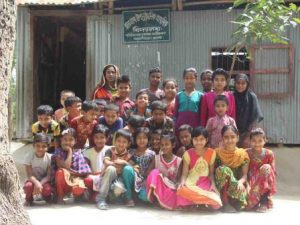 |
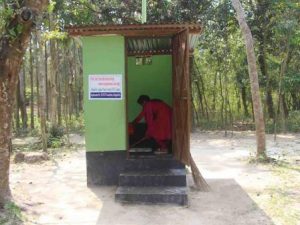 |
|
Students and a teacher of the school |
A girl student cleaning the latrine |
6. Rainwater Harvesting Project (Philippines)
(1) Outlines of the project of JWF Fund 2017
・Organization: Asset-Based Community Development with Equity Foundation (ABCDE Foundation) (#108)
・Project title: Rainwater Harvesting Project
・Country/Area: Philippines/Zamboanga del Norte
・Project period: October 2017 to March 2018
・Number of beneficiaries: 240 people (123 girls, 109 boys and 8 teachers)
・Cost: 1,121 USD (JWF Fund: 1,000 USD, Contribution by ABCDE Foundation: 121 USD)
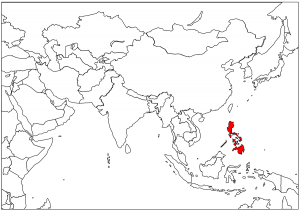 |
| Philippines |
Background:
The project site is mountainous and the water sources such as springs and creeks are far from the targeting site. People have to go down hills to fetch water and it takes around 1.5 hours. It is difficult for women to fetch water from the distant water sources and wash clothes every day. Severe lack of water has affected health, hygiene and the economic condition of local people.
Outputs:
1) Courtesy call was conducted.
2) 2 rainwater harvest tanks were installed.
3) Barrio Water Association was established.
4) Trainings on water management and vegetable gardening were held.
Because of these activities, the community people could use sustainable water source, and their living environments can be improved.
(2) Results of the follow-up observation in 2019
- Rainwater harvesting tank at elementary school
– The tank at the school is working properly as planned. The amount of water available from the tanks is enough to meet the needs of the beneficiaries. The users are mostly pupils of the school. April up to June which is the dry season is the highest-demand month.
– The members and officers of the parent-teachers associations are taking care of operation and maintenance of the tank, while occasionally a cleaning staff is hired by the school to clean the tank and attached facilities. - Rainwater harvesting tank at the community center
– The tank is working properly. However, the amount of water available from the tank is not enough to meet all the needs of the beneficiaries. During the water shortage season, from April to June when the demand is highest, the local residents get water from a spring located 4 kilometers away from the community.
– The Barrio Water Association is taking care of the tank and the assigned members of the association clean the tank in rotation. - Vegetable gardens
– After the project, vegetable gardening is a boom among the community people. About 60% of the people have their own vegetable gardens already. They are growing different types of vegetable on a regular basis. - Changes among the beneficiaries
– School students and local communities have already had steady access to safe drinking water.
Voices from the beneficiaries
- Ms. Mary Joy Patadilla, 37 years old, a user of the tank
– I use water from the tank for my household needs and my vegetable garden. I am very happy to have access to clean water. We live near the tank and we can access water readily while those who are far from the tank have difficulty in getting water. - Mr. Fidel Sayre, 46 years old, a user of the tanks
– I use water from the tank in the center. Previously I used to fetch water from a creek, but now I have good access. However, the water is still in short and there is a need to have 2 or 3 more tanks in our community. - Ms. Maredel Segayo, 32 years old, a user of the tanks
– I use the water from the tank frequently. This access to water is a big help to me. We have rules set by the water committee on the use of water. The committee is in-charge when delegating the cleaning of the tanks.
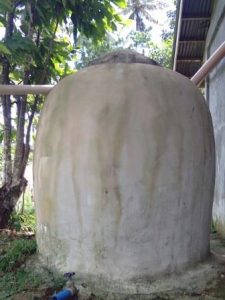 |
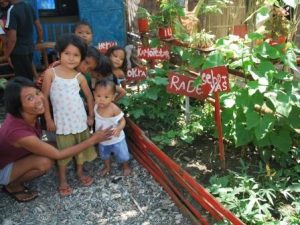 |
|
A rainwater harvesting tank at the elementary school |
Vegetable gardens |
(Reported by Sae Ishihara, Manager and Akie Gunji, Assistant Manager)
